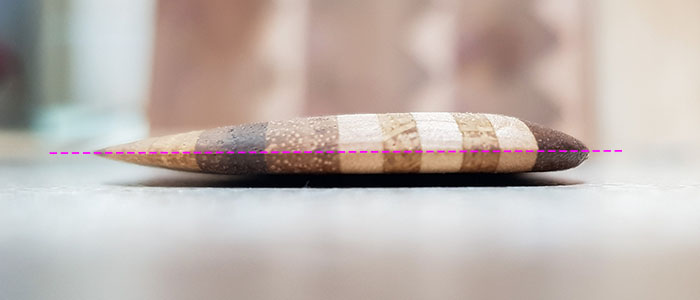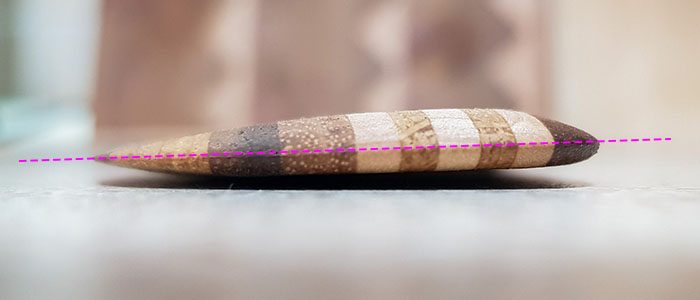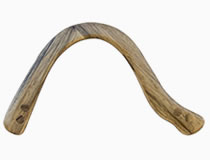The wooden boomerang may need to be adjusted. This is due to the fact that wood is subject to a natural deformation process under the influence of temperatures, loads and especially humidity. Wood of different breeds differs in density, porosity and hygroscopicity and change their sizes in different ways. For example, if the moisture content of wood changes by 1%, oak, on average, will change its parameters by 0.25% and maple by 0.3%. Detailed numerical data can be found in the reference books.
The rate of change in humidity is also different. This all leads to the fact that two glued lamellas of different breeds may be subject to bending. For example, this effect is used in some kettles, where two soldered plates, with different expansion coefficients, act as a switch, bending when a certain temperature is reached, turning off the power.

Depending on the type of boomerang, a change in geometry may affect its flight characteristics in different ways. For some boomerangs, a small bend may have almost no effect on its flight, for others the same bend will be critical. For example, long-range boomerangs generate low lift, and a small change in the angle of attack can greatly affect its flight.
In connection with all of the above, even proven and once configured boomerangs, over time, additional tuning may be required to obtain good flight behavior. In order not to make changes to the geometry of the boomerang, the best option would be to use examples of temporary solutions that make it relatively easy to customize your boomerang to your throwing style.
В случае если временные решения не приносят результата или вам нужно более кардинально изменить ваш бумеранг, то необходимо погнуть одно или оба крыла. Требуемая величина изгиба для каждого бумеранга может быть своя и определяться экспериментально. Вот некоторые рекомендации по настройкеIf temporary solutions do not bring results or you need to change your boomerang more radically, then it is necessary to bend one or both wings. The required bending value for each boomerang can be its own and determined experimentally. Here are some setup recommendations (terms here):
-
positive wing attack reduces overall flight;
-
a negative wing attack will increase the overall flight;
-
the positive angle of the dihedron increases the lift and provides a higher flight;
-
a negative dihedron reduces lift and leads to a lower flight.
The greater the angle of attack of the leading wing, the earlier the boomerang will begin to turn around, reducing the flight range.
Try to combine the settings until you get a customized boomerang. Make no more than one change at a time to see how the last setting affected the flight and make sure that you are on the right track. After making the settings, make at least 5-10 (the more, the better) starts at different angles.
Checking and setting up
Before you start setting up the boomerang, you need to check its geometry. Place the boomerang on a flat surface and press the elbow, pressing it completely against the surface. If the wings have a positive dihedron, then the tips will rise above the surface. In the same position, check the angles of attack and possible gaps.

After you make the bend, check the boomerang in the same way.
To bend a wooden boomerang, it is necessary to heat the part of the boomerang in which it is necessary to bend. To do this, you can use a construction hairdryer, stove, iron or any other heating method. When using a hair dryer, I heat the boomerang from both sides for a few seconds with a temperature of 300°. You need to heat it carefully so as not to overheat the tree. It is better to repeat the procedure if the heating is insufficient. With strong heating of the glued products, the adhesive seam may disperse.

After heating, immediately load the boomerang, bending a little more than necessary, and fix this position for a few seconds. Then wait until the boomerang cools down and check what happened.
Do not make large bends and twists. As a rule, the boomerang requires only a small adjustment. For example, in the case of a long-range boomerang (LD), changing the position of the chord (angle of attack) by 1mm (the rear edge of the wing is in place, and the front edge has become higher / lower by 1mm) will lead to a significant change in flight.


With bends, you can set up almost any boomerang for a good flight (it is assumed that your boomerang is able to fly in principle). Modification of the profile, for example with sandpaper, should be done when you need to fine-tune the boomerang, and you understand what effect this or that change gives.
Fine-tuning of the boomerang, by grinding the profile, should be done when your boomerang is already flying well, and only a little adjustment of its flight path is required. After such a profile upgrade, it will be very difficult to return to the initial state, and sometimes even impossible.



